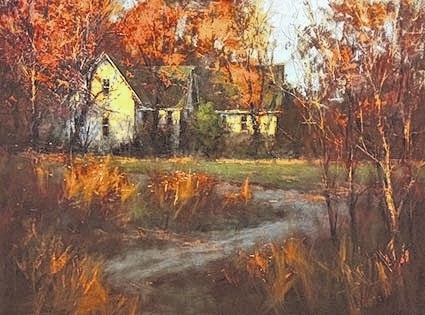
Editor’s note: Airstream will host a fine art invitational exhibit of landscape art, May 31-June 5, at its headquarters in Jackson Center. This is the last of a series of stories that profiled the artists whose work will be shown.
SIDNEY — To many, many people across the country, the paintings of Romona Youngquist feel like home.
The artist finds farmhouses, fields of flowers, barns and country lanes within a 10-mile radius of her Dundee, Oregon, studio, and renders them on canvas in such an evocative way that whether viewers live in the midwest, the south, the northeast or the west, the paintings take them back to “grandfather’s farm.”
So says Clark David Olson, partner in Bonner David Galleries in Scottsdale, Arizona. That’s a deliberate aim of Youngquist’s.
“I love home,” she said by phone recently. “I guess it’s psychological. The way the world is (becoming), people aren’t going to be seeing this. I want other people to see this and kind of remember what (home) is like.”
Olson represents Youngquist’s work, but he’s also a personal friend and a collector of her paintings.
“She is the most genuine, warm, caring human being. Romona is full of joy and beauty,” he said. “She has this huge kitchen. She loves to bake for people and she does karaoke.”
Youngquist admitted to singing with the recorded tracks, but she does so under an alias. She calls herself Monique, she laughed.
The singer/baker/animal lover — she raises chickens and has several dogs — knew at four years old that she would be a painter.
“I was in like a Headstart class. A teacher had us do a drawing. I did a rooster. The teacher held it up and said, ‘Look at this artist.’ I thought, ‘Ooh, I’m an artist,’” Youngquist said. As she grew up, she had momentary thoughts about being an architect or a veterinarian. But she always came back to painting.
“I didn’t grow up with museums or art. With me, it’s a calling. It chose me. I didn’t choose it,” she said.
She has only ever wanted to paint landscapes, and she has only ever wanted to use oils. What’s most surprising is that Youngquist is self-taught.
“I just went out and painted outside a lot. I looked at books of the artists I loved. Basically, painting outside taught me how to paint. You really learn how to see,” she said.
Her depictions of the countryside flow with warm colors: crimson poppies, yellow houses, red barns, orange autumn trees, golden sunsets. In many of them, solitary buildings are in sharp light and crisply defined while the natural world that surrounds the buildings is softer, more abstract.
“I want you to come into the painting. It’s the building you see first, to bring you in, and then (you) explore the hills or stream or path or over the hills,” Youngquist said. “That’s kind of sappy isn’t it? Is that sappy?”
What keeps the artworks from feeling maudlin or overly sentimental is the questions they ask a careful viewer. Following a Youngquist path from the foreground to the horizon might take a viewer to a pre-storm sky or to a porch shrouded in shadow or to a not-very-specific thicket of brambles. What will the storm do to those poppies? What’s hidden on the porch? Who’s in the brambles?
Youngquist’s paintings aren’t sappy. They’re intriguing. They don’t tell the whole story. They urge a viewer to find his own answers.
“I paint real places, but I move things around to make the design better,” she said. Because she’s painted in her own community for a long time, area residents know who she is. They get excited when they see her at work.
“People will say, ‘I saw Ramona painting. I should have brought my camera,’” Youngquist said. It’s not that they want to take pictures of her. They want to take pictures of what she’s painting. If she’s painting it, it must be special.
“I’m teaching them to see,” the artist said.
Youngquist works in her studio from studies she makes in the field and from photos. She has as many as 20 paintings in progress at once. A very short attention span takes her from one to another to the next. Her goal is to be as good a painter as George Innes. One of his paintings on view in the Clark Museum in Williamstown, Massachusetts, is what she’d like to own, could she have anything at all.
“He’s my favorite painter,” she said. The painting in the Clark “kind of changed me,” she added. “I saw it five years ago. I swore to myself I was going to do whatever I could to be the best painter I could to get to be at that level. It’s very simple but wonderful.”
She has worried that, being self-taught, she wouldn’t know how to get better.
“It’s hard,” she noted. The answer for her is going outside.
“I love nature. It’s always different, every day,” she said. And the job is always about finding the light, seeing the light.
“I can go past a scene for years and then one morning —,” she said. She carries a camera with her everywhere. This summer, she has set aside time to be out in the natural world she loves to paint things just for herself.
“I feel like I’ve been in the studio a lot. When you do for shows, you have to do what people think you should be doing,” she said.
And that work is quite popular, especially among Olson’s clients.
“She’ll send me four paintings and by the end of the day, two of them are gone,” he said. “She just captures rural America as no one else can.”


